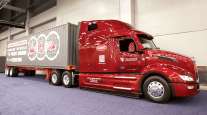Truck-Crash Deaths Rise
This story appears in the Nov. 18 print edition of Transport Topics.
Fatalities from accidents involving large trucks in the United States increased by 3.7% in 2012, rising to 3,921 people from 3,781 the year before, the National Highway Traffic Safety Administration reported.
Last year marked the third increase for annual truck-involved fatalities since hitting a low point in 2009 at 3,380 deaths.
American Trucking Associations characterized the report as “incomplete and misleading” because NHTSA defines a large truck as a commercial vehicle ranging from Classes 3-8.
“When the public hears the term ‘large truck,’ they naturally think of the millions of large tractor-trailers that deliver their most essential goods,” said ATA President Bill Graves. “However, data released today lump those tractor-trailers in with millions of smaller, non-freight-hauling vehicles whose crash rates are higher than in the trucking industry.”
NHTSA Administrator David Strickland said during a press conference that the statistics do not separate Class 8 tractors from delivery trucks and utility vans. Those numbers are still being sifted out.
While traffic safety officials are concerned that fatal crashes involving trucks have increased the past years, the roads remain safer than they were a decade ago, Strickland said: “We’re still better than we were.”
As for NHTSA’s plans for truck safety, he said, “We have a lot of activity under way to address these issues from a technology standpoint.”
He mentioned his agency’s proposed rule on electronic stability control and early collision-warning systems as examples.
The Federal Motor Carrier Safety Administration, which regulates truck and bus safety, said it is important to consider the fatality trend over time.
This report “remains noticeably lower than the 5,000-plus fatalities a year we experienced through the 1990s and early 2000s,” said spokeswoman Marissa Padilla.
“FMCSA will continue driving towards zero deaths by implementing common-sense initiatives like the updated hours-of-service rules to reduce driver fatigue — a leading factor in large-truck crashes — and educating the public about how to share the road safely with commercial trucks and buses,” Padilla said.
An America’s Road Team captain said he and his colleagues work frequently on those points.
“The highways are our workplace,” said Dale Williams, a captain with Trimac Transportation, “so we all need to do our part to share the road safely. That means allowing for proper following distances and safe passing, as well as abiding by all posted speed limits and other rules of the road.”
NHTSA said the largest percentage increase within the truck-involved fatality section was an 18% increase in deaths for occupants involved in multivehicle accidents, which rose to 273 people from 232 in 2011. The largest truck-involved fatality category by number was occupants of other vehicles, which rose by 4.8% to 2,843 from 2,713 in 2011.
Fatalities involving large trucks and pedestrians or bicyclists declined by 11% to 381 deaths from 428 in 2011, the report said.
NHTSA made note of this in the report, pointing out that 60.8% of large-truck occupants killed in 2012 died in single-vehicle accidents.
In looking at alcohol-related fatalities, NHTSA said they rose significantly for truck drivers but from a very low base. The agency recorded 80 impaired drivers in 2012, an 86% increase from just 43 truck drivers the year before.
Several times in the report, NHTSA noted it is difficult to talk about truck-related numbers with great precision.
“The number of fatal crashes involving large trucks is relatively small, so such variability in the number of fatalities is not unexpected,” the report said.
In looking at all highway accidents nationwide, NHTSA said the fatality rate rose to 1.14 deaths per 100 million vehicle miles driven from 1.1 in 2011. The injury rate also moved up to 80 people injured per 100 million vehicle miles driven from 75 the year before.
The agency also said preliminary data on the first half of this year show a decrease in the accident rate for all vehicles from the corresponding time in 2012. The 2013 data offered no updates on truck-related activity.
The Commercial Vehicle Safety Alliance had a mixed reaction to the report.
“Obviously, this is not something we’re happy about,” said Executive Director Stephen Keppler, referring to the fatality increase involving trucks. “But we have made significant strides in driving down those number in recent years.”
One of the most important policy changes CVSA would like to see, he said, is a requirement for truck passengers to use seat belts. Drivers must buckle up, according to FMCSA rules, Keppler said, but for now there is no such requirement for truck passengers.
Staff Reporter Scott Gutierrez contributed to this story.




